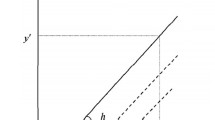Abstract
A probabilistic model was developed for coalescence of cracks randomly dispersed on the surface and having uniform orientation and statistically nonuniform length. The model makes it possible to calculate the probability of coalescence of any pair of closely located cracks with allowance for the interaction of the strain fields. The model has been modified for the case of coalescence of cracks having the biggest length in the sample. The initial parameters for determining the probability of coalescence are: mathematical expectation of the length of cracks, their surface density, the magnitude of the damaged area of the material (size-scale factor), and the level of the acting stress. The model obtained can be used to predict the life of a component from the criterion of formation of critical cracks by coalescence of dispersed defects.
Similar content being viewed by others
REFERENCES
S. N. Zhurkov, V. S. Kuksenko, and V. A. Petrov, “Is it possible to predict fracture?” in: The Future of Science [in Russian], Znanie, Moscow (1983), pp. 100–111.
R. P. Salganik, “Mechanics of bodies with a large number of cracks,” Izv. AN SSSR, Mekh. Tverd. Tela, No. 4, 149–158 (1973).
A. E. Elagin, “Interaction of surface cracks in a uniaxially stretched plate,” Probl. Prochn., No. 3, 14–17 (1990).
O. S. Minchenkov, N. A. Kostenko, and Yu. I. Popov, “On the interaction of crack-like defects located in three-dimensional bodies,” Probl. Prochn., No. 8, 34–37 (1990).
U. Lindborg, “A statistical model for the linking of microcracks,” Acta Met., 17, 521–526 (1969).
S. R. Ignatovich, “Critical values of the concentration of accumulated dispersed damages,” Probl. Prochn., No. 4, 61–68 (1995).
G. P. Cherepanov, “Current problems in fracture mechanics,” Probl. Prochn., No. 8, 3–13 (1987).
S. R. Ignatovich, “Prediction of the coalescence of dispersed defects,” Probl. Prochn., No. 2, 71–77 (1992).
V. V. Bolotin, Service Life of Machines and Structures [in Russian], Mashinostroenie, Moscow (1990).
B. A. Fedelich, “A stochastic theory for the problem of multiple surface crack coalescence,” Int. J. Fract., 91, 23–25 (1998).
P. J. E. Forsyth, “A unified description of micro-and macroscopic fatigue crack behavior,” Int. J. Fract., 5, 3–14 (1983).
C. M. Sah and H. Kitagava, “Crack growth behavior of fatigue microcracks in low-carbon steels,” Fatigue Fract. Eng. Mater. Struct., 9, No. 6, 409–424 (1986).
N. Gao, M. W. Brown, and K. J. Miller, “Crack growth morphology and microstructural changes in 316 stainless steel under creep-fatigue cycling,” Fatigue Fract. Eng. Mater. Struct., 18, No. 12, 1407–1422 (1995).
S. R. Ignatovich, “Regularities in multiple fracture of alloy ÉI698VD under low-cycle loading,” in: Aerospace Technical Equipment and Technology [in Russian], Issue 26, Kharkiv Aviation Institute, Kharkiv (2001), pp. 136–139.
Y. Ochi, A. Ishii, and S. K. Sasaki, “An experimental and statistical investigation of surface fatigue crack initiation and growth,” Fatigue Fract. Eng. Mater. Struct., 8, No. 4, 327–339 (1985).
R. N. Parkins and P. M. Singh, “Stress corrosion crack coalescence,” Corrosion, 46, No. 6, 485–499 (1990).
X. J. Xin and E. R. De Los Rios, “Interactive effect of two coplanar cracks on plastic yielding and coalescence,” Fatigue Fract. Eng. Mater. Struct., 17, No. 9, 1043–1056 (1994).
S. R. Ignatovich and F. F. Ninasivincha Soto, “Stochastic model for the formation of nonuniformity of dispersed crack sizes. Part 1. Steady-state crack growth,” Probl. Prochn., No. 3, 104–113 (1999).
S. R. Ignatovich and F. F. Ninasivincha Soto, “Stochastic model for the formation of nonuniformity of dispersed crack sizes. Part 2. Nonsteady-state crack growth,” Probl. Prochn., No. 4, 59–67 (1999).
E. S. Venttsel and L. A. Ovcharov, The Probability Theory and its Engineering Applications [in Russian], Nauka, Moscow (1988).
V. A. Petrov, “On the mechanism and kinetics of macrofracture,” Fiz. Tverd. Tela, 21, No. 12, 3681–3686 (1979).
E. Gumbel, Statistics of Extreme Values [Russian translation], Mir, Moscow (1965).
Rights and permissions
About this article
Cite this article
Ignatovich, S.R., Kucher, A.G., Yakushenko, A.S. et al. Modeling of Coalescence of Dispersed Surface Cracks. Part 1. Probabilistic Model for Crack Coalescence. Strength of Materials 36, 125–133 (2004). https://doi.org/10.1023/B:STOM.0000028302.80199.da
Issue Date:
DOI: https://doi.org/10.1023/B:STOM.0000028302.80199.da




